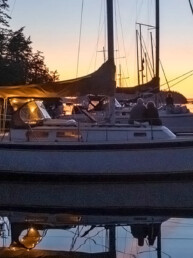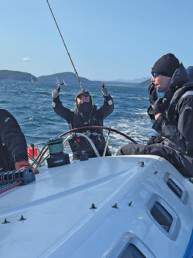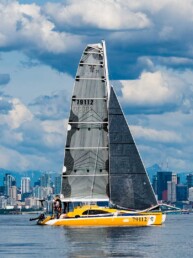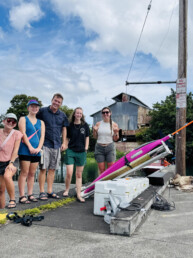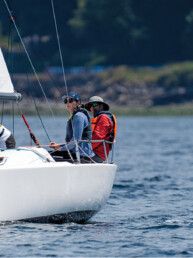In our latest Throwback Thursday, we follow the Rooks brothers on an adventure to the San Juan Islands in a decidedly unique cruising craft.
After spending a year-and-a-half living in Vancouver, British Columbia, I moved back home to Puget Sound this June. Both the Canadian scenery and the people are special, but certain border-restricting world events made being away from my family and home waters no longer tenable. As soon as I got home, the mission was clear: get Grasshopper in the water and head to the San Juans.
“What is that thing, anyway?” Funny, Grasshopper and I never get asked that question! Not three times at the gas station, or five times at the boat launch, or a dozen times at the marina… But seriously, folks, it’s a freaky-looking boat that happens to be the most practical boat I’ve ever been aboard.
Built by multihull mage Russell Brown, it started as an experiment to build an efficient boat out of orphaned parts. Russell’s alchemy turned discarded 20-foot Tornado catamaran hulls, an extra-long-shaft 15hp Honda, leftover carbon mast sections, and spare composites into this beach-cat-runabout. As wild as it looks, it’s really a stable and dry “pickup truck of the seas.” The whole thing only weighs 500 pounds—including the engine!— and has one hell of a window sticker tagline: 15hp = 15 knots = 1 gallon/hour.
Russell’s favorite use for Grasshopper was mobbing from Port Townsend to Desolation Sound over two days: roughly 100 miles, 7 hours, and 7 gallons of gas from PT to Lasqueti; then about the same again up to Desolation.
That trip obviously can’t happen right now, but my brother Coop and I figured we could use those cruising capabilities to catch up to our third brother, Ted, and his girlfriend, Emily, already in the San Juans after a couple of days aboard their Montgomery 17, Over Easy.
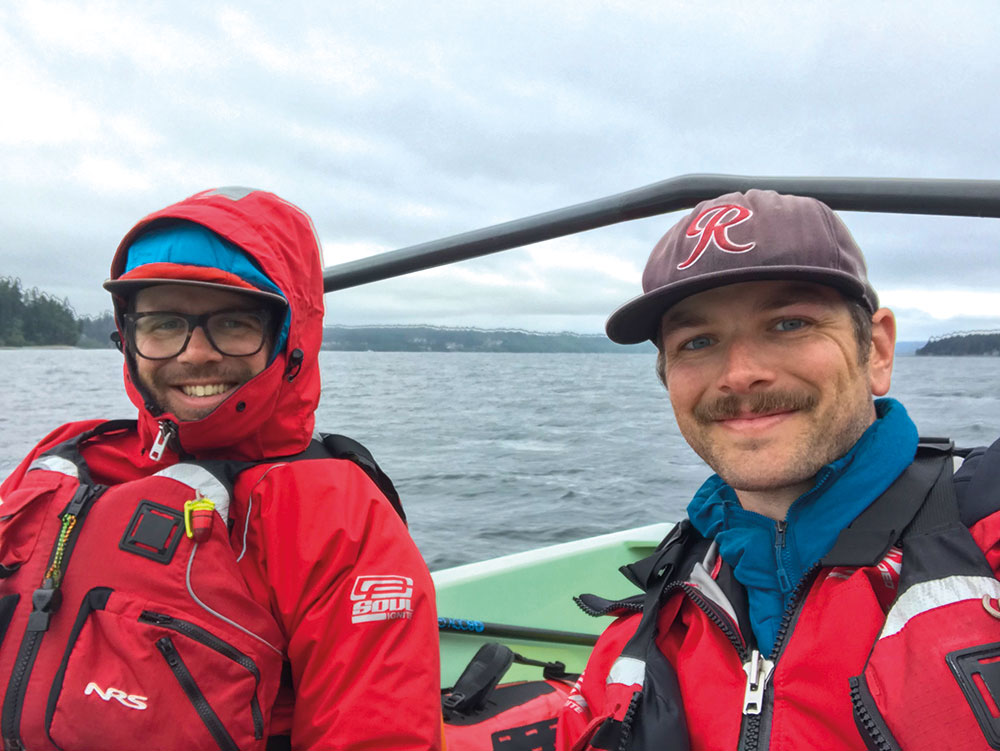
The forecast kept getting worse as our Tuesday departure date approached. “Sunny and 70s” slid to partly cloudy, then to windy and rainy. We went to bed Monday night disheartened, thinking our plans might get postponed. “Wait, what?!” we asked ourselves incredulously as we woke up on Tuesday morning to a gray drizzle. “We rowed and sailed a fat dinghy to Alaska through squalls and gales… we can enjoy a motorboat ride to the San Juans regardless of the weather.” With that, we threw on our drysuits, loaded up Grasshopper, and cast off the lines. When in doubt, choose adventure.
Thanks to Grasshopper’s ability to effortlessly cover ground, we were able to get pretty creative with our float plan. We started by hopping up the inside of Whidbey Island, finally greeted by the sun along Camano. We stopped for a toast to our maternal grandparents, whose ashes we spread there last summer. Encouraged by the current, we sliced up the Swinomish Slough, bursting past the rail bridge to see the beautiful, familiar peaks of Lummi, Guemes, and Cypress rising to greet us like old friends. We stopped for another toast at Guemes Island, where our paternal grandparents are buried, and lamented the familial battle which caused us to lose the cabin they built there in 1957. In the wake of that travesty, Coop and I resolved to always share what we had and to find other ways to make the San Juans ours.
“Hopping” makes you do things you wouldn’t do in any other boat, finding a weird place that eschews any normal Venn diagram overlap between sail and powerboats. From a sailor’s perspective, you’re so amazed by COGs (course over ground) in the teens that you feel like you can go check out that little bay over there well off course or circumnavigate the island you just got to because it only takes a few happy minutes. For those used to most powerboats, the efficiency tempts that Prius-driver smugness. We used 20 gallons over the four-day cruise from Bainbridge to the San Juans and back. One of Puget Sound’s ubiquitous 50-foot planing K-Swiss shoes (probably named Perseverance) would be lucky if it managed even one hour wake-making around the Salish Sea on that amount of dino-juice.
One of my favorite parts of hopping is how the combination of efficiency, handling, and 1-foot draft encourages you to get off the bee-line and hug the coast or get so close you can see the bottom whizzing under the hulls. Might as well go catch that bay’s eddy, gaining 2 knots “against” the current. Might as well do Seattle to the San Juans and back in four days through rain and wind!
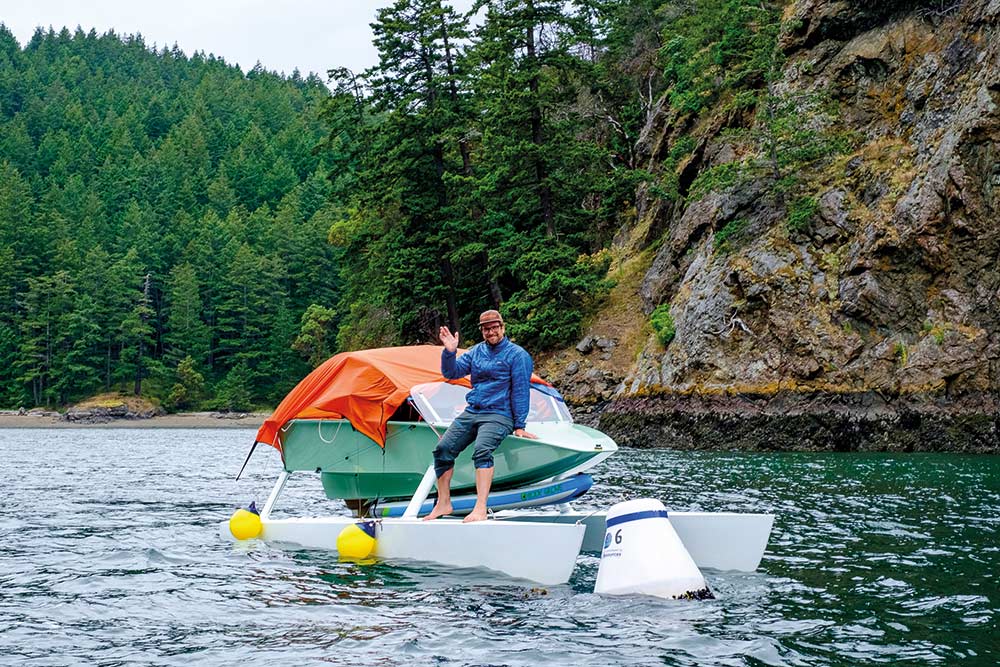
When I got Grasshopper, one of my first goals was extended camp-cruising. I love sleeping aboard—we exclusively slept aboard Bunny Whaler for the R2AK—so Russell and I made a platform to span the bench seats in the pod, creating something like a 6’x5′ truck bed—just enough for two big guys to sleep comfortably. A generic rainfly (the same one we used for R2AK) and some tent poles work perfectly to create a dry Grasshopper shell.
Though short, our trip served up that treasured San Juans magic. Smells, sounds, and feelings jostling deep-seated memories. Epic forest hikes through burn-buttressed old growth. Time melting like Dalí clocks. More bald eagles than Bayliners. Each morning began with rolling up the tent’s sides, Jetboiling some coffee, and peering out of our floating pickup-truck bed. Nothing beats a reflective morning spent boatwatching in a beautiful anchorage. We even had one of those hilarious “what the heck are you doing here?!” run-ins, stumbling upon Russell Brown himself and tying up to his R2AK-famous Gougeon 32, Incognito. Accidentally running into friends on tiny, otherwise-empty islands feels like the universe conspiring with you.
All in all, we did about 250 miles in 20 hours of driving on 20 gallons of gas—not quite reaching the tagline economy figures, but pretty good for two 200-plus pound dudes, gear, and four days worth of Rainiers.
While sailing remains the undisputed heavyweight champ of environmentally-friendly propulsion, Grasshopper proves the alternative doesn’t have to involve twin diesels or twice that many outboards, multiple heads, an ice maker, or 60 feet of lineal guest moorage. And it was merely the first salvo from Russell to demonstrate a better way; he now has other, more efficient designs. If you’re interested in more efficiency, capacity, and wild looks, keep an eye out for his new power-single-outrigger design!
From the October, 2020 issue of 48° North.
Nate Rooks
Nate Rooks was raised on Bainbridge Island, WA, and now lives in Vancouver, BC. He’s Marketing Director and West Coast Video Producer for boating website Off CenterHarbor.com, where you can find videos about his R2AK and Seventy48 adventures.


